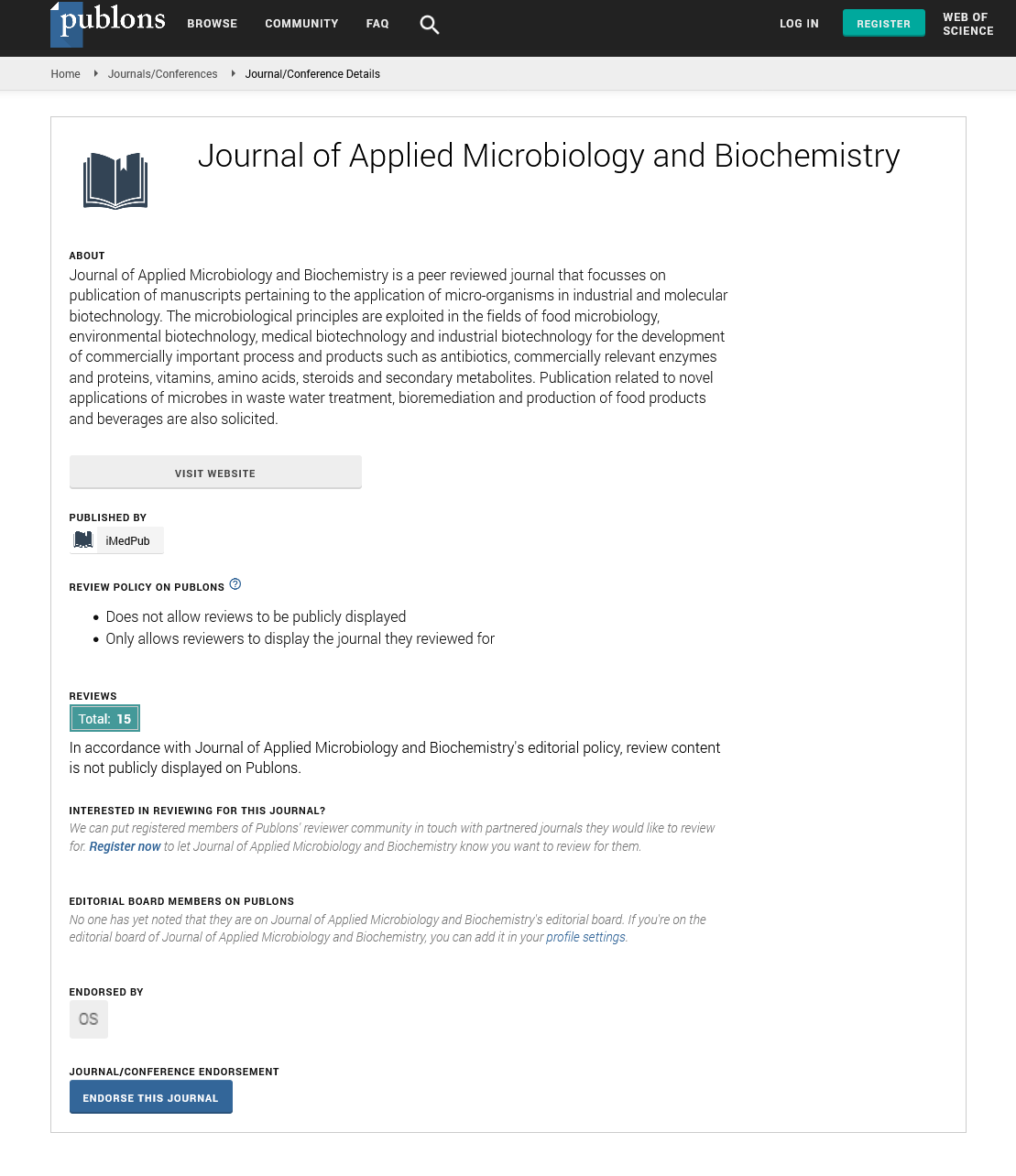ISSN : ISSN: 2576-1412
Journal of Applied Microbiology and Biochemistry
Abstract
Medicinal Plants 2020: Metagenomic-based screening and molecular characterization of yams-infecting viruses by High-Throughput Sequencing and Pox marker
To date Dioscorea (Yams) in Kenya is a neglected crop, notwithstanding its potential as food and in pharmaceutics as a drug source. Research on neglected crops specifically Dioscorea is a sure way of sensitizing the scientific community and policy makers about it. Several viruses of different genera have been reported to infect yam (Dioscorea spp.). The full diversity of viruses infecting yam, however, remains to be explored.
High-throughput Sequencing (HTS) and use of POX marker methods are progressively being used in the discovery of new plant viral genomes and metabolism processes in plants.
In this study, i will employ HTS on yam to determine whether any undiscovered viruses will be present that would restrict the international distribution of yam germplasm. The finding will work on discovery of a new virus sequence present. Thirty one (31) yam samples will be tested and have tentatively named as virus “yam virus Y” (YVY) .The metabolic reaction which may bring mutation will be tested by use of Peroxidase marker as they achieve the Arabiodisis process in metabolic of the organism. Complete genome sequences of two YVY viral isolates will be assembled and further finding will be done to text five open reading frames (ORFs). ORF1 encodes a large replication-associated protein, ORF2, ORF3 and ORF4 constitute the putative triple gene block proteins, and ORF5 encodes a putative coat protein as yam contain dioscorin which is full of protein. Considering the species demarcation criteria of the family Betaflexiviridae, YVY should be considered as a novel virus species in the family Betaflexiviridae. Further finding work will be needed to understand the association of this new virus with any symptoms and yield loss and its implication on virus-free seed yam production.
Keywords: RNA-Seq, virus detection, Betaflexiviridae, next-generation sequencing; HTS
This Work is presenting at 6th World Congress on Medicinal Plants and Marine drugs (Medicinal Plants 2020- Webinar) on June 24-25, 2020
Introduction
Yams, (Dioscerea spp), which is one of the most important subsistence crop cultivated in Eastern Africa is an annual tropical tuber crop that has tuber with a 25–30% energy content. Yams is therefore one of the most important subsistence crops that are cultivated in Eastern Africa which has been neglected.
Viral diseases, which can often occur as multiple infections, are a major constraint on yams production, and can cause plant stunting, reduced foliage, decreased tuber energy content, and, in individual plants, yield losses of up to 93% . While members of 140 virus species can naturally or artificially infect yams, only twelve of these species have so far been found in Africa, from which, only three have been reported from E. African. Viruses in eight of these twelve species are seedborne a factor that seriously hampers their effective control. For example, seed transmission can reach 2% for YV, 6.9% for virus—a strain of Yam mosaic virus (YMV), and 13.3% for cucumber mosaic virus (cMV; . Given that a far broader diversity of yams-infecting viruses has been discovered elsewhere in Africa, it is likely that additional yams-infecting viruses remain to be discovered in Kenya. The limited available knowledge on yam infecting viruses in this country hinders the control of diseases, particularly with respect to the production of disease-free seeds and the creation of virus-resistant yam varieties. Hence, the main objective of this study is to further investigate the diversity of yam new viruses in Kenya by use of HTS and POX marker.
Problem statement
The question of Dioscorea species under cultivation in Kenya formed the basis of this study. This study aimed at solving this through molecular phylogeny using DNA and RNA nucleotide sequences relating them to Known African species and species with information in the gene bank. The study also target the newly virus in yams which hinder the metabolic reaction of the yams consequently lowering the level of Dioscorin which hold a lot of protein which add the nutrition value of yams.
Justification
Dioscorea is an important crop both for food and due to its medicinal potential. Dioscorea taxonomy both in Kenya and globally has been very challenging to taxonomists based on morphological characterization. Several reasons have been linked to the difficulty in Dioscorea species taxonomy. First, Dioscorea taxonomy is challenging due to complexity and plasticity of taxonomic character within a species hence difficulty in their identification and due environmental changes the virus has bring mutation in virus and yams. Second, Dioscorea has been a neglected crop by researchers globally. Clear differentiation of species is of utmost importance for breeding purposes. Mapping species of a given organism is essential not only for conservation purposes but also for breeding purposes. Molecular phylogeny can be used to position virus species in morphologically complex taxa in Dioscorea by use of High-Throughput Sequencing and Pox markers, the virus is prone and affect the yams genetic composition hence lower the productivity of yams.
Note: This work is presenting at 6th World Congress on Medicinal Plants and Marine Drugs on June 24-25, 2020 webinar
Author(s): Moses Mathengemose
Abstract | PDF
Share This Article
Google Scholar citation report
Citations : 342
Journal of Applied Microbiology and Biochemistry received 342 citations as per Google Scholar report
Journal of Applied Microbiology and Biochemistry peer review process verified at publons
Abstracted/Indexed in
- Google Scholar
- China National Knowledge Infrastructure (CNKI)
- Cosmos IF
- Directory of Research Journal Indexing (DRJI)
- Publons
- Secret Search Engine Labs
Open Access Journals
- Aquaculture & Veterinary Science
- Chemistry & Chemical Sciences
- Clinical Sciences
- Engineering
- General Science
- Genetics & Molecular Biology
- Health Care & Nursing
- Immunology & Microbiology
- Materials Science
- Mathematics & Physics
- Medical Sciences
- Neurology & Psychiatry
- Oncology & Cancer Science
- Pharmaceutical Sciences
